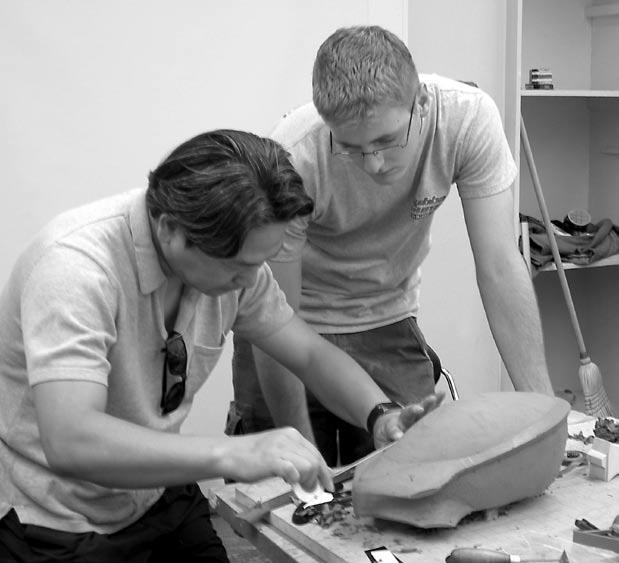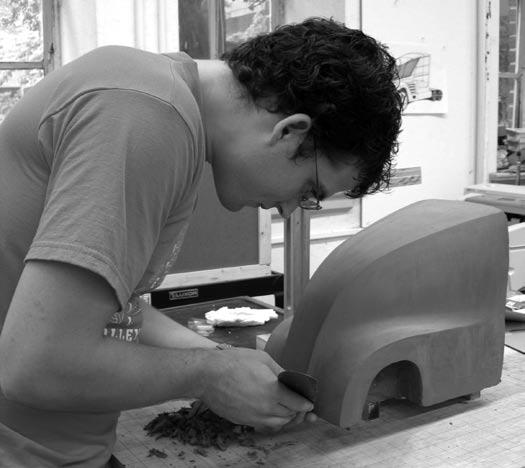
5 minute read
Molding Automotive Designers
16 I n his five years teaching at the College of Design, Associate Professor of Industrial Design Bong-il Jin has earned a reputation among his students as a powerhouse.
Jin hails from Seoul, Korea, with experience as both an academician and a professional automotive designer. In talking about his teaching, Jin points out the different education system.
Advertisement
Because of the differences in preparation (here is lot easier than Korea but not fixed), Jin finds that “You can mold [U.S. students] to be more flexible. They are creative. They can incredibly improve in a short time,” he says.
He encourages his students to enter competitions and to focus on one project. “I know companies’ goals and what they want,” says Jin. “I search last year’s winners and look for trends. I help with brainstorming and I filter their projects and give them clear directions based on my research.”
During Jin’s tenure his students have been successful in competitions including Motortrend Design Competition, Marine Alliance Scholarship Competition, LexMark International Printer Competition, and NY International Auto Show Traffic Safety Competition.
Jin holds a Master of Product Design from Hong Ik University in Seoul, Korea; a Special Certificate of Transportation Design from Art Center College of Design in Pasadena, Calif.; and a BFA of Industrial Design from Hong Ik University.
From 1983 to 1990, he worked for Kia Motors Company (now Hyundai KIA), designing concept and production cars. He then served as chief designer for four years at Daewoo Motors (now GM-Daewoo). He taught transportation design at Kun Kuk University and Young Nam University in Korea and product and transportation design at Sook Myung Womens University and Myung Gi University from 1995 to 1999. He was a department chair of industrial design at Narai Academy of Industrial Design from 1995 to 1998.
DESIGN INFLUENCE / FALL 2005 Steven Bockmann learns clay finishing techniques from Bong-il Jin.
Jin also has designed various products at Tandem Design Associates, a design consulting agency.
Students flock to Jin because he knows his subject well, and helping his students learn and improve is what’s important to him. “I love teaching, and my students trust me because they see my work and I show them everything.
Industrial Design and Mechanical Engineering Student Jeff Poon credits Jin with being part of the reason he came to NC State. He had Jin as a teacher in Design Camp and was really impressed with him when they worked on transportation ideas for aliens.
Poon says, “I wanted to learn more about car design and sketching skills. Bong makes us do needs-based research and is environmentally conscious.” Talking to students in his senior-level summer studio, you get the feeling that they are being pushed beyond what they thought they could do – and they enjoy it. In their comments, Jin’s expertise and focus on developing students into better designers is obvious.
Industrial Design Sophomore Steven Bockmann, from Raleigh, took the summer studio from Jin because he wanted to have a head start in automotive design skills. “He obviously knows us and he is very inspi rational as a teacher,” says Bockmann. “He’s excited about teaching and he makes you glad you are taking the class.”
According to Jin, he trains during the first four weeks, giving the students have a short-term project. He checks their understanding of the design process and teaches and evaluates them along the way. “I push them very hard until they stand alone,” he says.
After they finish their first project, Jin’s students work on two or three more projects, and he encourages them to use references to understand recent market and design trends and to get design clues to reduce the amount of time wasted. They aim to get the best result for the design problem they are working on.
Steve Chaney, a master’s student from Dallas, worked with Jin on an independent project – an automated public toilet. Chaney says, “He has a big personality and will tell you honestly if your design is bad, and because he is honest, you learn more.”
Students Bee Lee and Mike Bissinger say that learning from Jin has changed their design process.
Lee, an Industrial Design Senior, says, “Jin makes you see things that you didn’t before. I knew nothing and learned a lot from him on how to make a design that can actually be produced. He encourages us to get ideas from nature because there is no copyright and it helps simplify our shapes.”
Bissinger, a second-year Track Three student who has an under graduate degree in graphic design, says there is “a noticeable change in the way I work to build a case for my design.”
Bissinger had Jin in the studio that worked with Purpleshell, a start-up company located on Centennial Campus. Jin is the principle investigator on the Purpleshell project to design a router/server with the end user in mind. “On that project, Bong was able to help me go from the process of graphic design to industrial design. Our focus is on process and research. The process is superficial if you don’t have an idea about how the product will be used,” adds Bissinger.
Track Three Graduate Student Glenwood Morris says that Jin is “one of the best professors in form and function – workflow and how to fit it all in the bus. He helped us with the human factors and how to do the seating, work spaces, safety issues.” Morris had Jin in a studio that worked on plans for a mobile radiation van. For Jin to stay current with trends, he spends a lot of his time visiting retail stores to research trends, pricing, finishing material and technology and customer demands, which change constantly. He also researches world issues, economics, levels of international students design and evaluates new software and other devices.
As Jin says, being a good designer is not being a skill master but being a ‘culture leader’ through mass production.


Glenwood Morris works on a clay model of his truck design.










